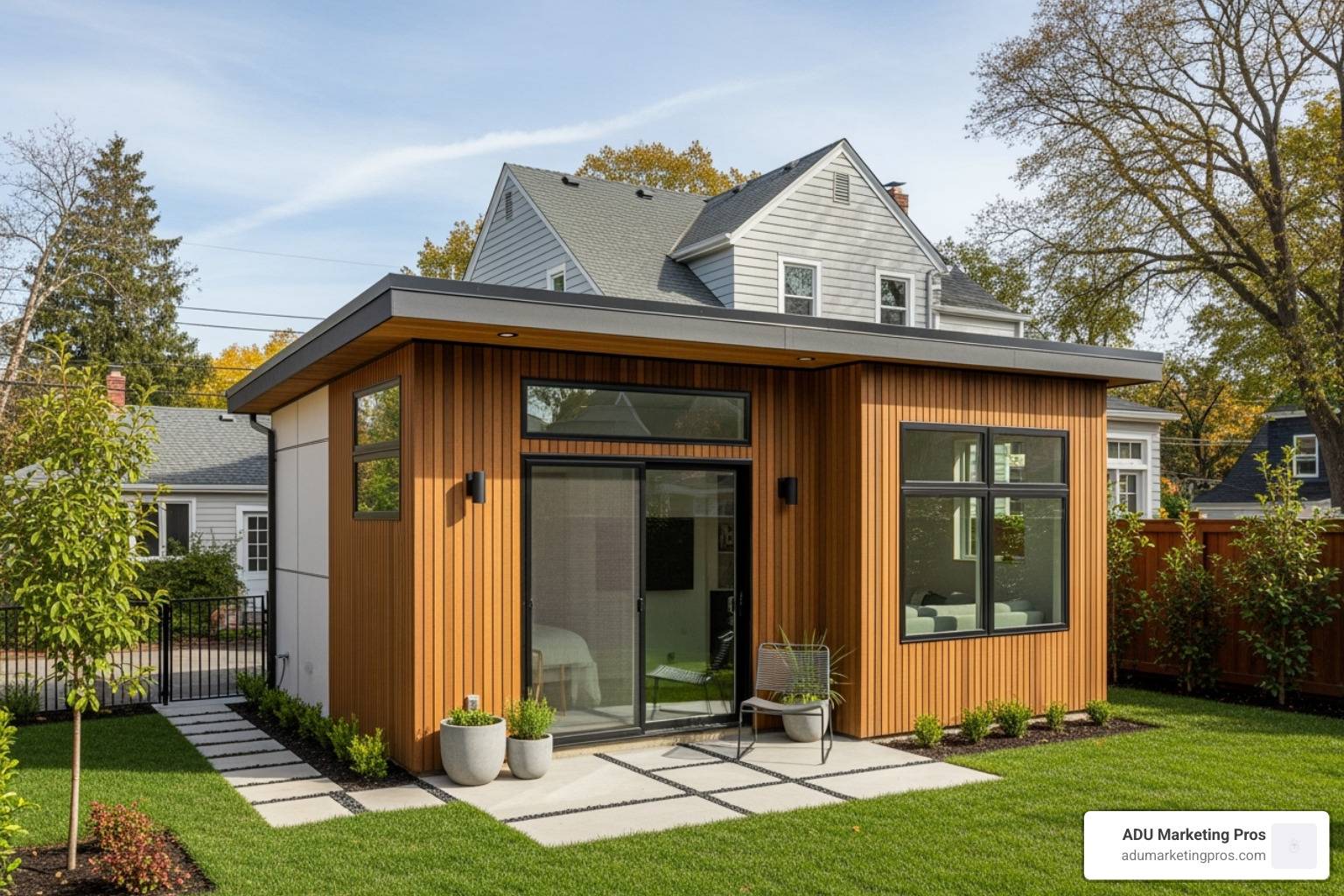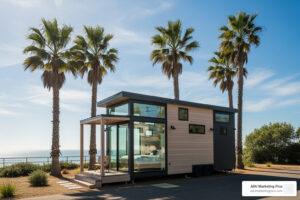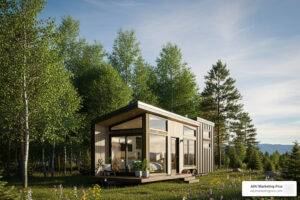Why Understanding Your Guest House ADU Options Matters
When homeowners consider adding a secondary dwelling to their property, the term guest house ADU often surfaces, creating a fog of confusion. Are they the same thing? Can you use the terms interchangeably? The answer is a firm no, and the distinction is one of the most critical a property owner can make. The choice you make has profound implications for your finances, legal standing, and long-term property goals.
This isn’t just a matter of semantics; it’s a fundamental difference in legal definition, intended use, and financial potential. Let’s clarify the core concepts right away:
Key Differences at a Glance:
- ADUs (Accessory Dwelling Units) are fully independent living spaces. They are legally defined as residences with their own kitchens, bathrooms, and separate entrances, designed and permitted for long-term occupancy.
- Guest houses are legally defined as accessory structures for temporary lodging. They are extensions of the main home’s hospitality, often lacking full kitchens and explicitly prohibited from being used for long-term rental.
- Legal status differs dramatically – ADUs are a legal housing solution that can be rented out, while guest houses are for non-paying visitors only.
- Building codes and costs vary – ADUs must meet the rigorous standards of a primary residence, often leading to a more complex and costly build. Guest houses typically have a simpler, less expensive permitting and construction process.
This distinction has never been more important, especially in states like California, which is grappling with an estimated 3.5 million housing unit shortage. Lawmakers have aggressively promoted ADUs as a key part of the solution, passing legislation that streamlines permitting and allows for units as small as a 150-square-foot studio. From the outside, a new backyard structure might look the same whether it’s an ADU or a guest house. But inside, and in the eyes of your local planning department, they are worlds apart.
Whether you’re exploring options for multigenerational living to keep family close, seeking a reliable source of rental income to combat rising costs, or simply want a private, comfortable space for visiting friends and family, understanding these differences is paramount. Making the wrong choice can lead to costly fines, legal battles, or a structure that fails to meet your needs. This guide will walk you through every critical detail, ensuring your investment aligns perfectly with your long-term vision.
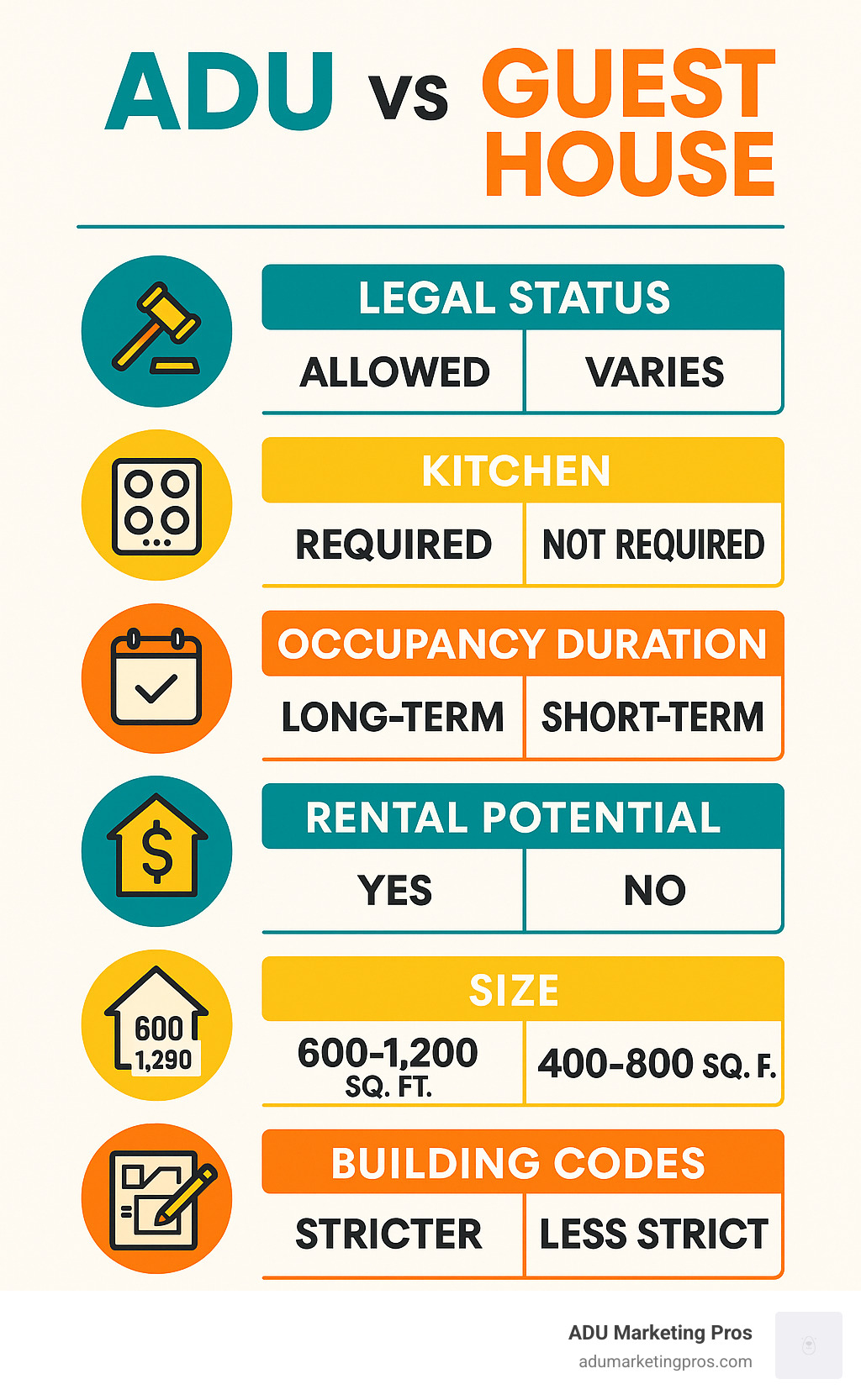
What is an Accessory Dwelling Unit (ADU)?
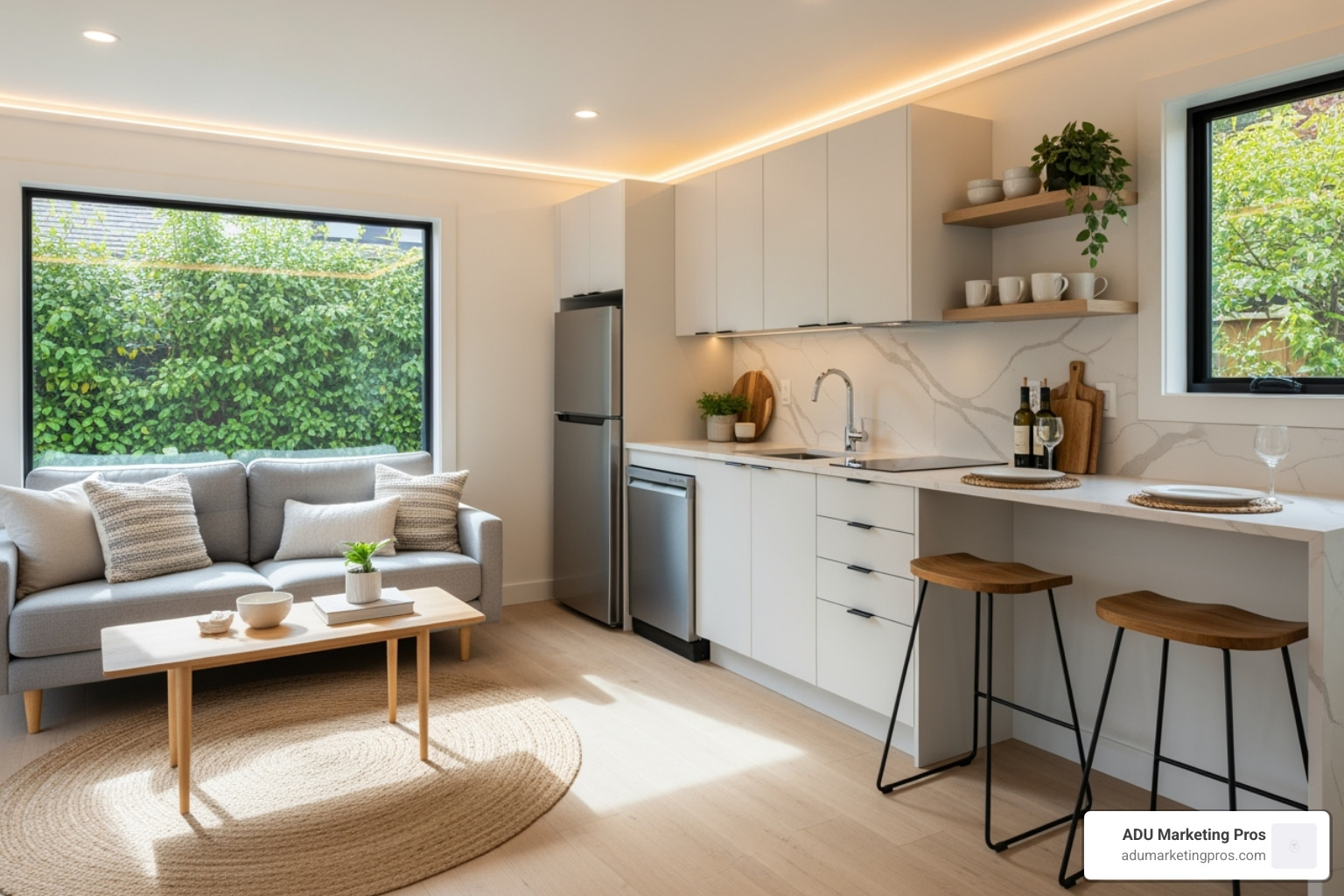
An Accessory Dwelling Unit (ADU), historically known as a granny flat or in-law suite, is a complete and independent secondary home located on the same property as a primary single-family residence. It’s not merely a spare room or a converted shed; it is a legally recognized, self-contained dwelling. To qualify as an ADU, a structure must contain three essential components: a full kitchen (with a stove, sink, and refrigerator), a full bathroom, and a separate entrance. These features ensure it can function as a standalone home for long-term living.
ADUs offer unparalleled versatility, making them a powerful tool for homeowners. They can be attached to the main house, built as a standalone cottage in the backyard, or ingeniously created from existing space like a garage or basement. This flexibility allows an ADU to solve multiple modern challenges simultaneously, from providing dignified, independent living for aging parents to generating significant rental income that can offset mortgage payments or fund other life goals. Unlike a temporary guest house, a permitted ADU is built to the same stringent building codes as a primary home, ensuring it is a safe, durable, and valuable year-round residence. For any homeowner serious about maximizing their property’s utility and financial potential, exploring comprehensive ADU Building Plans is the essential first step.
Types of ADUs
The beauty of ADUs lies in their adaptability to different properties, budgets, and needs. Each type offers a unique set of advantages:
- Detached ADUs: These are standalone structures, often called backyard cottages or DADUs. They offer the highest degree of privacy for both the main home residents and the ADU occupants, making them ideal for renters or family members who value independence. They can be custom-built on-site or constructed using prefabricated methods, which can sometimes speed up the timeline.
- Attached ADUs: These units are built as an addition to the primary house, sharing at least one wall. This can sometimes make construction more cost-effective by leveraging the existing structure and simplifying utility hookups. They are a great option for keeping family members close, such as an elderly parent who may need occasional assistance.
- Garage Conversions: This is one of the most popular and cost-effective ADU types because it repurposes an existing structure. By using the existing foundation, framing, and roof, homeowners can save significantly on construction costs. However, it requires careful planning to ensure proper insulation, waterproofing, and compliance with all living space codes, and you will lose your covered parking.
- Basement Conversions (or other interior conversions): These ADUs transform existing space within the home’s footprint, such as a basement or a large primary suite, into a separate living unit. This is often the most discreet option but requires careful attention to ceiling height, emergency egress (windows), and soundproofing.
- The Junior ADU (JADU): A JADU is a specialized, smaller unit (no more than 500 sq ft) created entirely within the existing walls of the primary home. It requires an efficiency kitchen and may share a bathroom with the main house. California law mandates that the property owner must reside in either the main house or the JADU, making it a perfect solution for housing a student, a caregiver, or for a single-person rental.
Understanding the specific regulations in your area is crucial. The California ADU Requirements provide a detailed overview, but you must always consult your local jurisdiction’s planning department.
The Purpose of an ADU
Building an ADU is a strategic decision that creates lasting solutions and long-term value.
- Addressing the Housing Shortage: On a macro level, ADUs gently increase housing density in existing residential neighborhoods without constructing large, disruptive apartment complexes. They are a key strategy for creating more affordable housing options.
- Fostering Multigenerational Living: ADUs are the gold standard for families looking to live together while maintaining personal space and independence. They provide a safe and accessible home for aging parents (aging in place) or a launchpad for adult children saving for their own home.
- Generating Substantial Rental Income: A legally permitted ADU can become a significant source of revenue. In high-demand areas, a one or two-bedroom ADU can generate thousands of dollars per month, quickly turning a construction expense into a high-performing asset.
- Creating Flexible, Future-Proof Space: An ADU is an adaptable investment. Today’s home office can become tomorrow’s rental unit. A studio for an aging parent can later become a guest suite for visitors or an art studio. This ensures your property evolves with your changing life needs.
For a deeper dive into the nuances, this resource on Understanding the Differences: ADU vs. Guesthouse offers valuable perspective on making the right choice for your specific situation.
What is a Guest House?
A guest house is your property’s dedicated hospitality suite—a separate structure designed exclusively for the temporary accommodation of non-paying visitors. Unlike an ADU, which is a legal dwelling, a traditional guest house is built for short-term stays. You might hear them called by charming names like “casitas,” “pool houses,” or “backyard bungalows.” From a legal standpoint, local authorities classify them as “accessory structures,” not “dwelling units.” This classification is key, as it generally leads to a simpler permitting process, less stringent building requirements, and lower construction costs compared to an ADU.
The fundamental distinction lies in the intended use: guest houses are for “staying,” not “living.” This single difference dictates everything from the allowable amenities inside to its legal and financial limitations.

Common Features of a Guest House
Guest houses are intentionally designed for comfort and convenience over a short period, stopping short of the full independence required for a permanent home.
- Sleeping Area: A dedicated space for rest is the primary feature, which could be a bedroom or an open-plan studio layout.
- Bathroom: This can range from a simple half bath (powder room) to a three-quarter bath (with a shower) or a full bath (with a tub).
- Kitchenette (Not a Full Kitchen): This is the most critical and legally enforced feature. A guest house will have a kitchenette, which typically includes a mini-fridge, microwave, coffee maker, and perhaps a small sink. It will specifically lack a full-size stove, oven, or 220-volt outlet. This is a zoning requirement designed to prevent the structure from being used as a permanent, independent dwelling.
- Shared Utilities: To reduce costs and reinforce its accessory status, a guest house almost always shares its water, electricity, and gas connections with the main house. It will not have separate utility meters.
- Shared Access: While it may have a separate door, legal access is often considered to be through the main property. This is suitable for friends and family but not for long-term tenants who require legal, unimpeded access.
Intended Use and Limitations
The charm and simplicity of a guest house come with significant and legally binding limitations that every homeowner must respect.
- Hosting Family and Friends: This is the sole intended purpose. It provides a wonderful, private space for guests and hosts alike, making visits more comfortable for everyone.
- No Rental Income Allowed: This is the most important limitation. It is illegal to rent out a guest house for any form of compensation, whether for long-term or short-term stays (like Airbnb). Attempting to do so violates zoning laws and can result in severe penalties, including hefty fines and even orders to remove the prohibited features (like the kitchenette) or demolish the structure.
- Occupancy Limits: To prevent circumvention of rental prohibitions, most municipalities impose limits on how long a guest can stay, often capping it at 30 or 60 consecutive days. This reinforces the structure’s role as a temporary lodging space, not a permanent residence.
Think of your guest house as a personal amenity—a private oasis for hobbies, a home office, or a quiet retreat—not a business opportunity. The legal framework is built around the concept that guests are “staying” as an extension of your household, not “living” as independent residents.
The Core Differences: A Head-to-Head Comparison
While the casual phrase guest house ADU might seem to describe a single type of building, it actually represents two fundamentally different structures with distinct legal identities, functions, and financial outcomes. Though they can be designed to look nearly identical from the curb, their internal features and legal DNA are worlds apart. An ADU is, for all intents and purposes, a small house or apartment in your backyard. A guest house is legally equivalent to a private hotel room on your property. Internalizing this distinction is the most important step in your planning process.
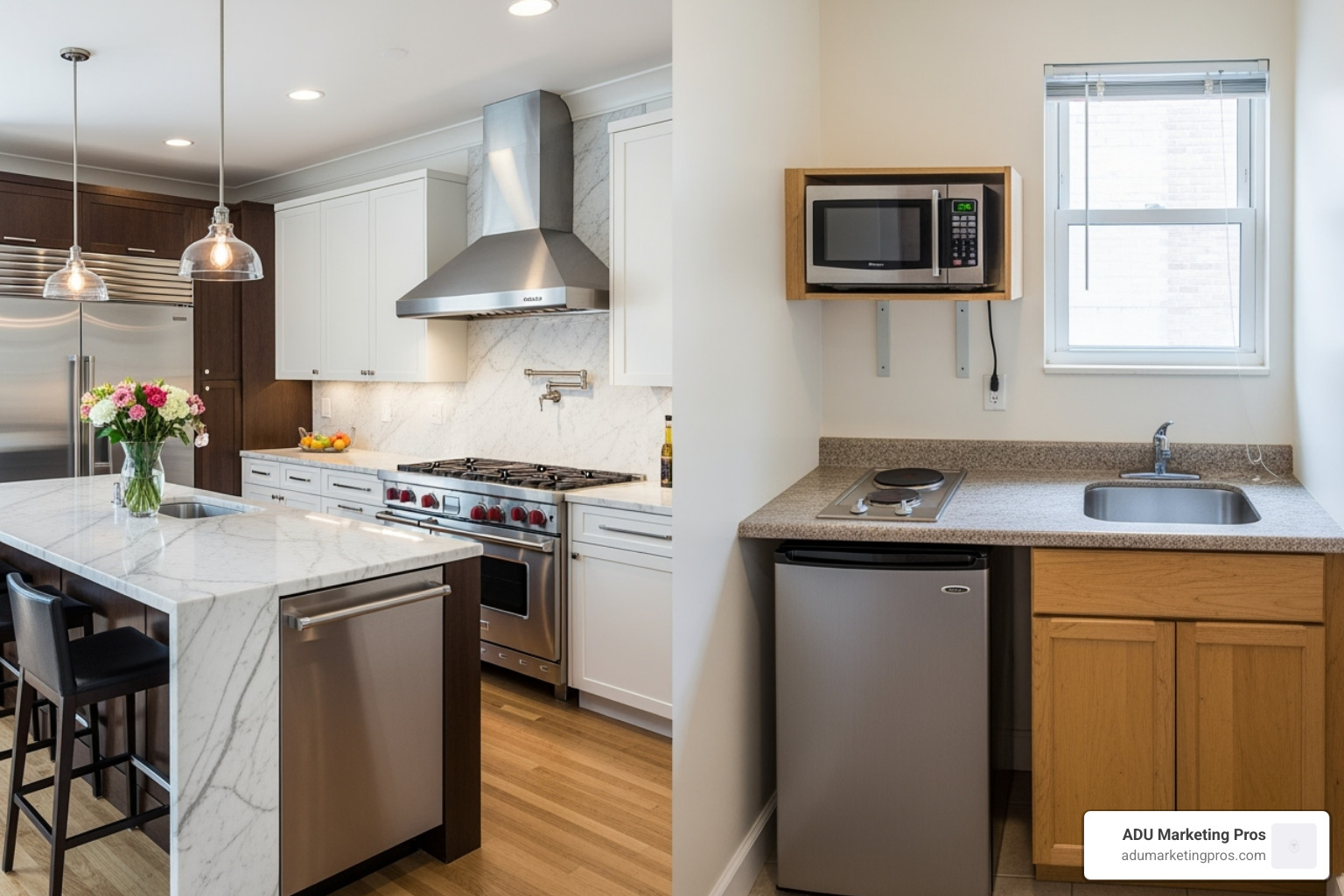
Purpose and Duration of Use
The primary dividing line is the intended length and nature of occupancy.
- ADUs are specifically designed, permitted, and built for long-term living. They serve as primary residences for occupants who are “living” or “renting” the space. This permanence is the basis for all other regulatory requirements.
- Guest houses are built for temporary visits. Occupants are “staying” or “visiting” for short, defined periods, such as a holiday, a family visit, or a long weekend. They are not intended to be anyone’s permanent home.
Building Codes and Zoning Regulations
Here, the paths of ADUs and guest houses diverge sharply, with significant consequences for cost and complexity.
ADUs face stricter regulations because they are legal, rentable dwelling units. They must meet the same comprehensive health, safety, and energy efficiency standards as a primary home. This includes specific requirements for insulation, fire-rated construction, foundation engineering, and more. While recent California legislation (like AB 68 and SB 9) has streamlined the approval process, reduced setbacks to as little as 4 feet, and waived many impact fees, the project must still clear a high bar for compliance. The permitting process is therefore more involved and expensive.
Guest houses have more regulatory flexibility because they are classified as non-habitable accessory structures. The permitting process is often simpler, faster, and cheaper. However, this flexibility comes with rigid restrictions, most notably the prohibition of a full kitchen and any form of rental occupancy. Municipalities enforce these rules diligently. For an excellent example of how a city defines these structures, the Town of Paradise’s comparison guide offers clear insights into the official classifications.
Size and Amenities
The amenities allowed in each structure are a direct reflection of their legal use.
ADUs are complete, self-sufficient homes. They are legally required to have a complete kitchen, which includes a stove, oven, full-sized refrigerator, and sink. They must also have a full bathroom. To support their independence, they often have separate utility meters for electricity, gas, and water, which is a requirement in some areas for new construction.
Guest houses are intentionally minimalist. They are restricted to a kitchenette (mini-fridge, microwave) or may have no kitchen facilities at all. A full kitchen is explicitly prohibited by zoning to prevent illegal rental use. Utilities are almost always tied to the main house, reinforcing their status as a dependent, accessory structure.
| Feature | Accessory Dwelling Unit (ADU) | Guest House |
|---|---|---|
| Primary Purpose | Long-term independent living, rental income, family housing | Temporary lodging for non-paying guests, personal retreat |
| Kitchen Requirements | Full kitchen (stove, oven, sink, fridge) is mandatory | Kitchenette only (mini-fridge, microwave); full kitchen is prohibited |
| Occupancy Type | Permanent residents, long-term tenants, family members | Short-term visitors, non-paying guests only |
| Rental Legality | Legally rentable for long-term occupancy (and short-term in some cities) | Strictly not legally rentable for any duration or compensation |
| Typical Size | 150 sq ft (CA min) up to 1,200 sq ft, or larger based on local rules | Often 640 sq ft or less; size may be limited by local ordinance |
| Utility Connections | Often requires separate meters for gas, electric, water | Utilities are shared with the primary residence |
| Property Tax Impact | Triggers a blended reassessment, increasing property taxes | May cause a minor reassessment based on value added |
| Financing Options | Eligible for traditional financing (renovation loans, HELOCs, etc.) | Typically funded with cash or personal loans due to non-income status |
Choosing Your Build: A Practical Guide to the Guest House ADU

Making the decision between an ADU and a guest house is a deeply personal choice that must align with your family’s needs, your financial strategy, and your long-term vision for your property. This isn’t just a construction project; it’s a significant investment of time and money. Before you contact a single builder or designer, sit down and honestly assess your motivations by asking these critical questions:
- Primary Goal: What is the number one reason for this project? Is it to generate rental income (ADU) or to have a private space for visitors (Guest House)? Be specific.
- Occupancy: Who will use this space and for how long? Are you planning for a long-term tenant, an aging parent living there for years, or family visiting for a few weeks at a time?
- Financials: What is your realistic, all-in budget for design, permits, and construction? Are you looking for an investment that generates cash flow, or are you comfortable with an expense that adds lifestyle value?
- Landlord Role: Are you prepared for the responsibilities of being a landlord, including marketing the unit, screening tenants, handling maintenance, and navigating landlord-tenant laws?
- Property & Zoning: What does your property’s layout realistically allow? Crucially, what do your local zoning regulations permit? A visit or call to your local planning department is a non-negotiable first step.
Answering these questions with clarity will illuminate the correct path for your guest house ADU project and prevent costly mistakes.
Advantages and Disadvantages of Each Option
Let’s break down the real-world implications of each choice to help you weigh the trade-offs.
Guest House: Pros & Cons
- Pros: The construction process is generally simpler, faster, and less expensive due to less stringent code requirements. It provides a wonderful, dedicated space for guests or a personal retreat (office, studio) without the complexities of tenancy. The impact on your property taxes is typically lower than that of an ADU.
- Cons: The absolute biggest drawback is the inability to generate any rental income. Its use is legally restricted, and it cannot be easily converted into a legal long-term housing solution if your needs change in the future. This lack of flexibility can limit your property’s future potential.
ADU: Pros & Cons
- Pros: The potential for substantial, consistent rental income is the primary advantage. Many ADUs in California can generate $2,000-$3,500+ per month, creating a powerful income stream. They significantly boost property value by adding a legal, rentable unit. They also offer incredible flexibility for housing family, renting, or using as a high-end home office.
- Cons: The initial costs are significantly higher due to the requirements for a full kitchen, bathroom, and stricter building codes. The permitting process is more complex and time-consuming. Renting the unit comes with all the responsibilities and potential challenges of being a landlord.
Financial Factors for Your Guest House ADU Project
The financial divergence between ADUs and guest houses is stark. While a guest house costs less upfront, an ADU is a true financial asset designed to pay for itself and generate profit.
Let’s run a simplified scenario: An ADU in a desirable area might cost $200,000 to design and build. If it generates $2,800 per month in rent ($33,600 annually), it has the potential to pay for itself in 7-10 years (after accounting for taxes, insurance, and maintenance), and then provide decades of passive income. This doesn’t even include the significant equity it adds to your property.
Both structures add value, but an ADU provides a much greater increase in your property’s appraisal value because it represents a legal, income-producing housing unit. When you build an ADU, your property taxes will be reassessed based on a “blended assessment,” meaning only the value of the new construction is added to your existing assessment, not the whole property. A guest house will also trigger a reassessment, but typically for a lower amount.
Don’t forget to factor in permit costs and financing. ADU permits can be more expensive, as detailed in our ADU Permit Cost California guide. However, financing an ADU is often easier because lenders see the income potential. Options include a Home Equity Line of Credit (HELOC), a cash-out refinance, or a renovation/construction loan. For a deeper dive, explore our resources on ADU Construction Cost.
Making the Final Call on Your Guest House ADU
After guiding hundreds of homeowners through this process, we’ve seen clear patterns emerge.
Choose an ADU if:
- Generating rental income is a primary or secondary goal.
- You need a long-term, independent housing solution for family members.
- You want maximum flexibility for the future use of the space.
- You see your property as a financial asset and want to maximize its value.
- You are prepared to take on the legal and financial responsibilities of being a landlord.
Choose a Guest House if:
- Your only goal is to comfortably host short-term, non-paying visitors.
- You have a tighter budget and prioritize a simpler, faster construction process.
- You have absolutely no desire to ever be a landlord.
- You want a personal retreat (like an art studio, gym, or office) and local laws for accessory structures are favorable.
The decision ultimately comes down to your vision. Both options can enhance your lifestyle and add value to your property; the key is to choose the one that is legally permissible and perfectly aligned with your goals.
Conclusion
The journey to expand your property with a secondary structure begins with a critical choice, and the term guest house ADU sits right at this fork in the road. The decision between a true Accessory Dwelling Unit and a traditional guest house is one of purpose, legality, and long-term financial strategy.
To put it simply:
- ADUs are the definitive choice for flexibility, independence, and financial return. They are complete, self-sufficient homes that can legally house family members long-term, generate significant rental income, and substantially increase your property’s market value. An ADU is an investment in an income-producing asset.
- Guest houses excel at one thing: hospitality. They are simpler and typically cheaper to build, providing a private and comfortable space for visiting friends and family without the legal complexities or responsibilities of being a landlord. A guest house is a lifestyle enhancement and a property amenity.
Your financial outlook provides the clearest guide: an ADU is an investment designed to generate a return, while a guest house is a personal expense that adds lifestyle value. Neither is inherently better, but one will be definitively right for you.
Regardless of which path you lean towards, understanding your local regulations is the single most critical step. Zoning laws, building codes, and permit requirements vary significantly by city and county. These local rules will ultimately determine what is possible on your property. Your project’s success hinges on starting with a clear understanding of these regulations.
At ADU Marketing Pros, we have seen countless homeowners in competitive markets from Los Angeles and San Diego to San Jose, Sunnyvale, and Palo Alto transform their properties and their lives by making an informed choice. The key is to align your build with a clear, long-term vision.
Ready to take the next step from dreaming to doing? For expert guidance on navigating the complex regulatory and construction landscape, consider connecting with experienced tiny house builders in California who can help you turn your property’s untapped potential into a beautiful, functional reality.

